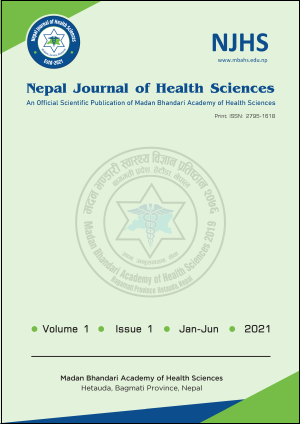Drug Utilisation Pattern in Ear, Nose and Throat Inpatient Department using WHO Prescribing Indicators
DOI:
https://doi.org/10.3126/njhs.v1i1.38720Keywords:
Drug utilisation, essential medicines, prescribingAbstract
Introduction: Assessment of drug utilisation pattern (DUP) based on World Health Organisation (WHO) drug prescribing indicators would enhance the standards of patient care at all levels of the healthcare. It helps to improve the quality of life in developing countries like Nepal.
Objective: To assess DUP in patients admitted in ear, nose and throat inpatient department at a tertiary hospital in Eastern Nepal using the WHO prescribing indicators.
Methods: A hospital based cross-sectional descriptive study was carried out in 96 patients in ENT department of a tertiary care teaching hospital from February-April 2019. Pre-designed proforma was used to collect the relevant data from the medical case sheets and drug charts. Descriptive statistics were calculated using Microsoft Excel 2010.
Results: Out of 96 patients, 52 (54.17%) were female. Most of the patients (46, 47.18%) were prescribed four drugs. Combination of Ibuprofen and Paracetamol (77, 19.74%) was the commonest prescribed drug. Ceftriaxone (62, 63.92%) was the most frequently prescribed systemic antibiotic. The average number of drugs per prescription was 4.06. None of the drugs were prescribed by generic name. Out of 360 drugs, only 118 (30.26%) were prescribed from National List of Essential Medicines (NLEM) and 117 (30.00%) drugs were fixed drug combinations. Ninety two (95.83%) patients had been prescribed at least one antibiotic.
Conclusions: The prescribing practices of essential medicines, generic drugs, antibiotics and injectable drugs showed deviation from the standard recommended by the WHO. The prescribers should be motivated to enhance prescription of drugs by generic names and from NLEM.
Downloads
Downloads
Published
How to Cite
Issue
Section
License
Copyright (c) 2021 Deependra Prasad Sarraf, Bajarang Prasad Sah

This work is licensed under a Creative Commons Attribution 4.0 International License.




